商务英语谈判 negotiation Principles.ppt-sl
- 格式:ppt
- 大小:307.50 KB
- 文档页数:68

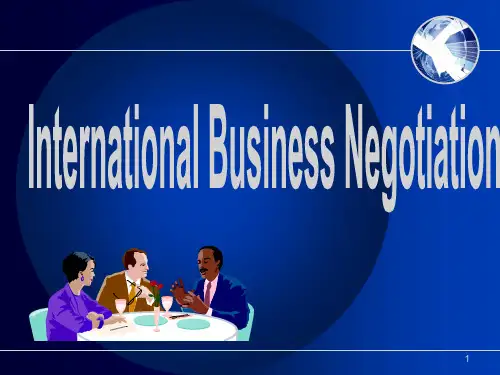
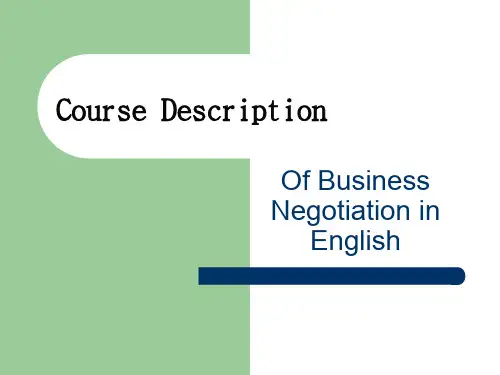
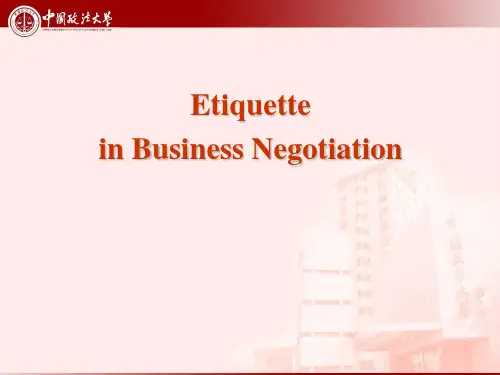

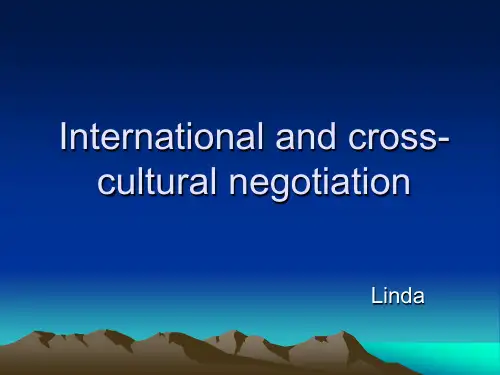



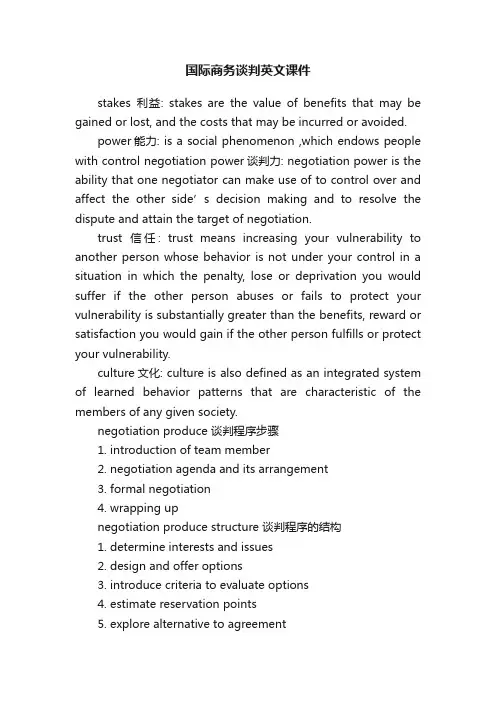
国际商务谈判英文课件stakes利益: stakes are the value of benefits that may be gained or lost, and the costs that may be incurred or avoided.power能力: is a social phenomenon ,which endows people with control negotiation power谈判力: negotiation power is the ability that one negotiator can make use of to control over and affect the other side’s decision making and to resolve the dispute and attain the target of negotiation.trust信任: trust means increasing your vulnerability to another person whose behavior is not under your control in a situation in which the penalty, lose or deprivation you would suffer if the other person abuses or fails to protect your vulnerability is substantially greater than the benefits, reward or satisfaction you would gain if the other person fulfills or protect your vulnerability.culture文化: culture is also defined as an integrated system of learned behavior patterns that are characteristic of the members of any given society.negotiation produce 谈判程序步骤1. introduction of team member2. negotiation agenda and its arrangement3. formal negotiation4. wrapping upnegotiation produce structure 谈判程序的结构1. determine interests and issues2. design and offer options3. introduce criteria to evaluate options4. estimate reservation points5. explore alternative to agreement6. reach an agreementstructure of business negotiation 贸易谈判的机构inquiry---offer---counteroffer—acceptancetarget level谈判三种目标1. desirable target :is what negotiations wish to attain but in reality ralely reach2. acceptable target :is what negotiation make all efforts to achieve3. bottom target :is what negotiations will defend and safeguard whichall their efforts信息的直接用途:problem solving信息的间接用途:strategic planningwhere to collect information信息的收集渠道1. international organization2. governments3. service organization4. directories and newsletters5. online servicefour cause of unwilling?不愿意做谈判准备的原因?1. lack of sensitivity2. limited cognition3. lack of familiarty4. inactivity and gambling mindfour steps 谈判准备的步骤?1. target decision2. collecting information3. staffing negotiation teams4. choice of negotiation venueswhen is the third party desired?什么时候选择第三方加入谈判?1. power is relatively lower than other counterpart3. negotiation goes impasse and no alternative available4. established norms and standards hinder the processwhen to choose third party’s venue(何时选择第三方谈判地点):1) first, the two negotiating parties are hostile and antagonistic to each other, or even engaged in a fighting against each other.2) second, negotiation goes into an impasse and no sign of rapprochement, impossible to carry on negotiation in neither party’s place.3) third, a dispute is stirred up when both parties strongly demand to host the negotiation.win-win model 双赢模式1. determine each party’s own interest and needs2. find out the other party’s interests and demands3. discuss the possibilities of making concessionwin—lose model 输赢模式1. determine each party’s own interests and stance2. defend one’s own interests and stance3. discuss the possibilities of making concession1.people: separate the people from problem2.interests: focus on interests but not positions3.gaining: invent options for mutual gain4.criteria: introduce objective criteriahow to tell a criterion is objective 如何客观品评判标准1. independent of wills and free from sentimental influence2. valid and realistic3. at least theoretically accepted by both sideshow to standards for successful negotiation判定谈判成功与否的标准1. satisfy the both valid interests, resolve the conflicts, protect interests2. highly efficient3. improve the relationshipneeds theory 需求理论五种1. physiological needs2. safety needs3. love and belonging needs4. esteem needs5. needs to for self-actualization6. needs to know and understand7. aesthetic needslaw of two level game 双层法规level 1 international level :relationship of interests and chances of success of negotiationno changesuccess possiblesuccess increasinglevel 2 domestic level :win—sets, the sets gain the necessary majority among the constituentsconclusion:the larger win—sets make the more likely an agreement at level 1the smaller win—sets can be a bargaining advantage for a country at level 哪些因素影响谈判力:1. motivation: a party’s power is increasing with decreasing of itsmotivation or the greater a party’s motivation is ,the weaker its relative.2. dependence: a party’s power is diminishing with increasing of itsdependence on the other party3. substitutes: one party’s indepen dence increase and thus its power isstrengthened when there are more substitutes available for considerationhow to stimulate motivation(如何刺激对方的动机):1.offering inducements2.demonstrating attractiveness3.getting external third party back4.placing a time limithow to increase substitutes(如何增加拟方替代):1.has alternatives which allow operating without the other party2.absorb the escalating cost of conflict3.can continue despite the other party’s discouraging effects on itssupportersdeterminants affecting a person’s trustful or mistrustful behavior(影响人的信任或不信任行为的决定因素):1. unchangeable elements: 1) childhood education; 2) professional or special trainingeffect or trust 信任的效应结论trust stimulates intellevtual development and originality, and leads to greater emotional stability and self-control. trust facilitates accepts and open of expression for establishing sound relationship among negotiating team members as well as between negotiating parties. negotiations based conversely, mistrust provokes rejection and defensireness, damages vollaboration in a group with wish high level of mistrust, members signal of mistrust and expect mistrust from others, thusproduce law level of trust.ac model:2. collaborating: sharing information & understanding; enlict finding a creative solution; cooperation; during4. avoiding: skipping meetings; avoid people; withholding information; delaying结论:the more stakes and power, the more assertiveness depends on alignment of interest and relationship; the more mutual interests and the more mutual trust, the more cooperativeness一次囚徒和多次囚徒的结论--one-short prison’s dilemma game rarely leads to cooperation--iterated prison’s dilemma games lead to cooperation and high trust 两分法分类:reward system; relationship; tangible issues; assumptions; strategy usedhow to build a coalition(怎样建立谈判联盟):1.setting coalition targets:(1) parties who can join;篇二:英文版商务谈判a是中国的卖方,b美国买方;咱们组是a公司成员leader(l):shi 主谈marketing(m):zhao lawyer(la):ruanfinancial(f):时technicist(t):金显而易见,我们就是b公司成员:gm:卢(andy)marketing executive:小花legal adviser:孙financial advisor:王大花professional: 康师傅卢: thank you for your warm reception. it will be excited if we can get a satisfactory result . ok, we would like to get the ball rolling(开始)by talking about prices.m: shoot.(洗耳恭听)id be happy to answer any questions you may have. 曌: your products are very good. but im a littleworried about the prices youre offering. m: you think we about be asking for more?曌: thats not exactly what i had in mind. i know your research costs are high, but what id like is a 25% discount.m: that seems to be a little high, miss. sweet. i dont know how we can make a profit with those numbers.曌: well, if we promise future business-volume sales(大笔交易)-that will slash your costs(大量减低成本)for making the products, right?m: yes, but its hard to see how you can place such large orders. wed need a guarantee of future business, not just a promise.曌: we said we wanted 1000 pieces over a six-month period. what if we place orders for twelve months with a guarantee?m: if you can guarantee that on paper, i think we can discuss this further. 卢: what’s about having a rest now? good rest, good spirit!ten minutes laterf: miss. sweet, we have considered you advice carefully. but even with volume sales, our coats for the products wont go down much.曌: just what are you proposing?王: thats a big change from 25! 10 is beyond my negotiating limit. any other ideas? f: i dont think i can change it right now. why dont we talk again tomorrow?王:sure. i don’t think our capital can allow we to make a deal in this price and this numbers.next daym:yeah, i hope so! and i hope we can make a concession to reach somemiddle ground.曌:i understand. we propose a structured deal(阶段式和约). for the first six months, we get a discount of 20%, and the next six months we get 15%.曌:then youll have to think of something betterm:how about 15% the first six months, and the second six months at 12%, with a guarantee of 3000 units?曌:thats a lot to sell, with very low profit margins.卢:(smiles) o.k., 17% the first six months, 14% for the second?! l:good. get it.康:how long is the quality guarantee period?t:2 years general. and we can guarantee that the quality is better.t:we can guarantee that our quality is one of the best in the world. we have the advanced research and development ability. whereas this is our first cooperation, we can extend it to 3 years.康: that’s good! thank you!la:for it is the first time for us to do business. it will be better having a good way to discover the disputes may appear between us.孙:sounds good! as the practices, we usually resolve the disputes with our partners visa arbitration.曌:wed like you to execute the first order by the 31st.m:ok, let me run through this again: the first shipment for 1000units, to be delivered in 27 days, by 31st june. the second shipment for 2000 units, to be delivered by 20 august 卢:fine , this deal promises big returns(赚大钱)for both sides. lets hope its the beginning of a long and prosperous relationship.l:yes ,through two days negotiation i argue that we havereached a win-win result and we are very pleased to cooperate with you for a long time.卢:that’s true! what’s the good time for us to sign the contract.m: as our arrangement. you would have a visit to the shaolin temple, over there you will learn the nature of chinese-kung fu. then we can sign the contract tomorrow morning!卢: wonderful! it’s can not be better more篇三:国际商务谈判课件国际商务谈判1谈判就是为达成协议,参与各方当事人通过信息交流与沟通,相互提出要求、互相让步与妥协的行为过程。
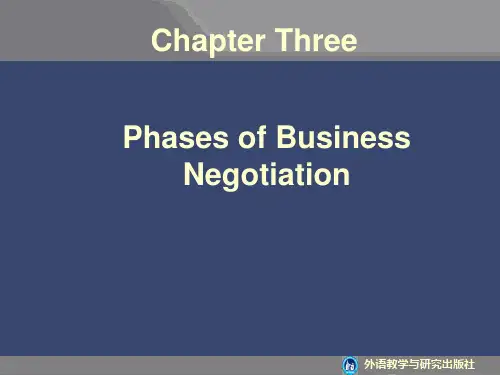
Chapter 1 Principles of Business Negotiation商务谈判的原则何谓商务谈判?谈判是人们为了协调彼此之间的关系,满足各自的需要,通过协商争取达到意见一致的行为和过程。
Negotiation takes place between human beings. It is the most common form of social interaction. Almost everybody inthe world is involved in negotiations in one way or another for a good part of any given day. People negotiate over where to gofor dinner, which movie to watch or how to split household chores.Negotiation, in its modern sense, is defined in The Roots of Sound Rational Thinking as follows: the ability to deal with business affairs, to arrange by discussion the settlement of terms, to reach agreements through treaties and compromise, andto travel through challenging territory. All of these suggest a purposeful effort to resolve problems through talking andintellectual maneuvering. Negotiation includes consultation, bargaining, mediation, arbitration, and sometimes, even litigation.Competitive style To try to gain all there is to gain(竞争式谈判)Accommodative style To be willing to yield all there is to yield(通融式谈判)Avoidance style To try to stay out of negotiation(回避式谈判)Compromising style To try to split the difference or find (妥协式谈判) an intermediate point according tosome principleCollaborative style To try to find the maximum possible (合作式谈判) gain forboth parties----by carefulexploration of the interests of allparties----and often by enlarging the pieVengeful style To try to harm the other(报复式谈判)Self-inflicting style To act so as to harm oneself(自损式谈判)Vengeful and self-inflicting style To try to harm the other andalso(报复和自损式谈判) oneselfPeople who go for the competitive style are known as hard-bargaining negotiators. They start off with outrageous demands, using threats and other tactics to get what they want. One side typically starts out high and the other low. Afterseveral rounds of offer and counter-offer, the negotiators end up “spl itting the difference”. In this form, negotiation is viewed asa game where each side tries to get the best deal for themselves. Neither side exhibits concern for the other side.1.1Principle of Collaborative Negotiation合作式谈判的原则Ⅰ. Collaborative NegotiationNegotiation can also assume the form of collaborative style. It involves people with diverse interests working togetherto achieve mutually satisfying outcomes. Collaborative negotiation is known by many names. Some popular names include “problem-solving negotiation”, “consensus-building negotiation”, “interest-based negotiatio n”, “win-win negotiation”, “mutualgains negotiation”, and so on.The goal of collaborative negotiation is to manage the dispute so that the outcome is more constructive than destructive. A destructive outcome results in damages and involves exploitation and coercion. Aconstructive outcome fosters communication, problem-solving, andimproved relationships.● The negotiation parties have both diverse and common interests.● The common interests are valued and sought.● The negotiation process can result in both parties gaining something.● The negotiating arena is controlled by enlightened self-interest.● Interdependence is recognized and enhanced.● Limited resources do exist, but they can usually be expanded through cooperation and creativity.● The goal is a mutually agreeable solution that is fair to all parties and effective for the community/group.The collaborative negotiation focuses on interests rather positions. Integrative solutions are obtained by understandingother’s self-interests, not by jostling for positions.The collaborative negotiation places value on relationship. It requires trust and relies on full disclosure of relevant information.The disadvantages of this approach are:●It may pressure an individual to c ompromise and accommodate inways not in his best interest.●It avoids confrontational strategies, which can be helpful at times.●It increases vulnerability to deception and manipulation by a competitive opponent.●It makes it hard to establish defi nite aspiration levels and bottom lines.●It requires substantial skill and knowledge of the process.●It requires strong confidence in one’s perceptions regarding the interests and needs of the other side.Ⅱ. Principled NegotiationIn this form, each side of the negotiating parties attempt to meet the other side’s interest as well as their own. By thoroughly understanding their own interest as well as the other’s, both sides are often able to arrive at solutions neither alone could have envisioned or made possible. In this type of negotiation, each side recognizes and accepts the legitimate interests of the other side and they are committed to dealing with differences constructively in order to advance their own self-interests. This has been called “collaborativeprincipled negotiation”, a concept set forth by Roger Fisher and William Ury in their book Getting to Yes: Negotiating Agreement Without Giving In.Principled negotiation is particularly oriented to collaborative negotiations. However, it can be used in competitive negotiations and inother aspects of conflict management. It is a method that is centered around four considerations (PIOC):● People: Separate the people from the problem.● Interests: Focus on interests, not positions (inte rests always underlie positions).● Options: Invent options for mutual gains.● Insist on using objective criteria.1.Separate the people from the problemFisher and Ury pointed out that “negotiators are people first”. There are always relational and substantive issues in negotiation. The relational issue tends to become entangled with the problem and the positional bargaining puts relational and substantive issues in conflict with each other. Fisher and Ury suggested that the negotiators separate the relationship from the substance and deal directly with the people problem.It is a feasible to deal with a substantive problem and maintain a good working relationship between negotiating parties. People problems are usually caused by inaccurate perception, inappropriate emotions and poor communication. In order to deal with those problems, three techniques are recommended for both parties to follow:A.Establish an accurate perception.●Conflict, very often, is not caused by what happens, but by ho w people perceive what happens.●Increase the capability of each party to see the other side’s point of view (for example, by reversing roles).●Avoid blaming the other party for your problems.●Discuss each other’s perceptions of the problem.●Get the other party to participate in the mutual activities.●Seek to make negotiation proposals consistent with the other party’s values.B.Cultivate appropriate emotion.●Your emotion affects that of the other party.●Recognize and understand emotio ns of both parties.●Make emotions explicit and legitimate.●Allow the other party to let off steam.●Stay calm with the other party’s emotional outbursts.C. Strive for better communication.● Negotiation is a process of communicating between pa rties for the purpose of reaching a joint decision.● Be an active listener and acknowledge what is being said.● Speak to be understood.● Avoid criticism that may hurt the other party’s feelings.● Speak for a purpose.2. Focus on interests, not positionsIn such a case, negotiators need to distinguish between interests and positions and focus on interests not positions. A position is what you want or must have. An interest is why you want what you want.Positions can be thought of as a one-dimensional point in a spaceof infinite possible solutions. Positions are symbolic representations of a participant’s underlying motivating interests. In negotiation, there are many kinds of interests: multiple interests, shared interests, compatible interests and conflicting interests. Indentifying shared and compatible interests as “common ground” can be helpful in establishing a found for additional discussions. “Easy points of agreement”can be indentified and the principles underlying those easy points of agreement can often be extrapolated to help resolve other issues. Methods for focusing on interests instead of positions are as follows:A. Identify the self-interests.● Explore and recognize the interests of the other party that stand in your way.● Examine the different interests of different people on the other side.● Respect your counterparty as human beings and recognize the needs and interests that underlie their positions.B. Discuss interests with the other party.●Give your int erests a vivid description. Be specific.●Demonstrate your understanding of the other party’s interests and acknowledge them as part of the overall problemthat you are trying to solve.●Discuss the problems before proposing a solution.●Direct the discussion to the present and the future. Stay away from the difficulties of the past.●Be hard on the problem but soft on the people.3.Invent options for mutual gainsHere are the steps for overcoming the obstacles and developing multiple solution options:A.Separate the act of inventing options from the act of judging them.●Run a brainstorming session.☆Before brainstorming:■Define your propose----what you would like to achieve at meeting.■Choose a few participant (between five and ei ght people)■Change the environment----select a time and place distinguishing the session from regular discussions.■Design an informal atmosphere----talking over a drink, meeting at a vacation lodge or any other forms that make participants feel relaxed.■Choose a facilitator----a facilitator is needed to keep the meeting on track, make sure everyone gets a chance to speak, and stimulate discussion by asking questions.☆During brainstorming:■Seat the participants side by side facing the problem.■Clarify the ground rules, including the no-criticism rule.■Brainstorm.■Record the idea in full view.☆After brainstorm:■Check the most promising ideas----mark those ideas that participants think are the best.■Explore improvements for prom ising ideas----take one promising idea and explore ways to make it better and practical.■Set up a time to evaluate ideas and make a decision.●Consider brainstorming with the other side; it can be very valuable.B.Develop as many options as possible before choosing one.●Adopt the four types of thinking in generating options.●Look at the problem through the eyes of different experts.●Develop different versions of agreement.●Change the scope of a proposed agreement----break the problem into smaller units.C.Search for mutual gains.●Identify shared interests.●Dovetail differing interests.4.Insist on using objective criteriaThe guidelines for objective criteria are:●Independent of wills of all parties.●Legitimate and practi cal.●Acceptable to all parties.After identifying objective criteria and procedures, it is time to discuss them with the other party. There are three basic points to remember:A.Frame each issue as a joint search for objective criteria.B.Reason and be open to reason as to which standards are most appropriate and how they should be applied.C.Never yield to pressure, only to principle----yield to an argument or presentation that is based on reason and principle,not to one based on pressure.1.2Principle of Interest Distribution利益分配原则In negotiations at the domestic level, there are two types of interests involved: personal and organizational; at the international level, there are three: personal, organizational and national.Organizational RolesPrinciples and Agents1.3Principle of Trust in Negotiation信任的原则Trust is something of great importance in negotiation. Professor Richard C. Reuben defined it as “a state involving expectations about another’s motives and actions with re spect to oneself in situations entailing risk of uncertainty”. In the outline of his Negotiation----Law 5810, he states that there are three types of trust in professional relationships:●Deterrence-based trust (威慑型信任)☆ Calculus-based trust (预计型信任)●Knowledge-based trust (了解型信任)●Identification-based trust (识别型信任)Ⅰ. Trust Building in Negotiation1.Speak their language2.Manage your reputation3.Make dependence a factor4.Make unilateral concessions your concessions6.Explain your demandsIn their book entitled The Only Negotiating Guide You Will Ever Need, Peter B. Stark and Jane Flaherty list fifteen things that a negotiator can do to build trust with his counterpart.1.Demonstrate your competence2.Make sure the nonverbal signals you are sending match the words you are saying3.Maintain a professional appearancemunicate your good intentions5.Do what you say you are going to do6.Go beyond the conventional relationship7.Listen8.Over-communicate9.Discuss the indiscussibles10.Provide accurate information, without any hidden agenda11.Be honest----even when it costs you something12.Be patient13.Uphold fairness14.Negotiate for abundance, not scarcity15.Take calculated risksⅡ. Maximiz ing Joint Gain1.4Principle of Distributive, Integrative & Complex Negotiation两分法谈判、双赢谈判和复杂谈判的原则Ⅰ. Distributive NegotiationJennifer E. Beer listed a set of distributive bargaining strategies in Culture at work:1.Preparation2.Opening offers3.Exchange information and arguments4.Concessions and decisionsⅡ. Integrative Negotiation。